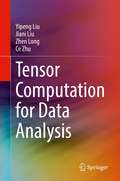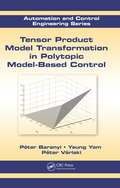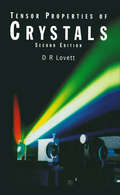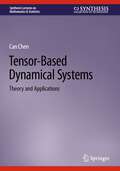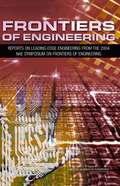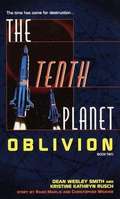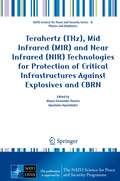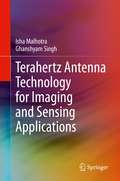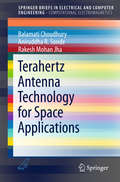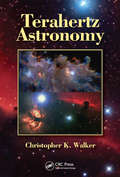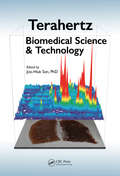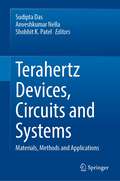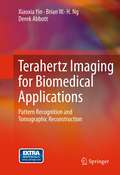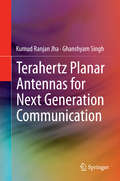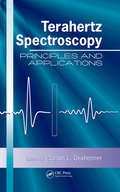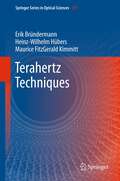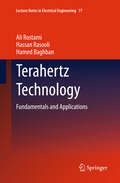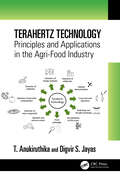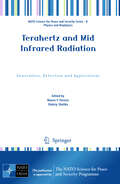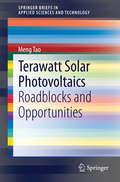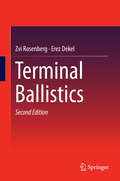- Table View
- List View
Tensor Computation for Data Analysis
by Ce Zhu Yipeng Liu Jiani Liu Zhen LongTensor is a natural representation for multi-dimensional data, and tensor computation can avoid possible multi-linear data structure loss in classical matrix computation-based data analysis. This book is intended to provide non-specialists an overall understanding of tensor computation and its applications in data analysis, and benefits researchers, engineers, and students with theoretical, computational, technical and experimental details. It presents a systematic and up-to-date overview of tensor decompositions from the engineer's point of view, and comprehensive coverage of tensor computation based data analysis techniques. In addition, some practical examples in machine learning, signal processing, data mining, computer vision, remote sensing, and biomedical engineering are also presented for easy understanding and implementation. These data analysis techniques may be further applied in other applications on neuroscience, communication, psychometrics, chemometrics, biometrics, quantum physics, quantum chemistry, etc. The discussion begins with basic coverage of notations, preliminary operations in tensor computations, main tensor decompositions and their properties. Based on them, a series of tensor-based data analysis techniques are presented as the tensor extensions of their classical matrix counterparts, including tensor dictionary learning, low rank tensor recovery, tensor completion, coupled tensor analysis, robust principal tensor component analysis, tensor regression, logistical tensor regression, support tensor machine, multilinear discriminate analysis, tensor subspace clustering, tensor-based deep learning, tensor graphical model and tensor sketch. The discussion also includes a number of typical applications with experimental results, such as image reconstruction, image enhancement, data fusion, signal recovery, recommendation system, knowledge graph acquisition, traffic flow prediction, link prediction, environmental prediction, weather forecasting, background extraction, human pose estimation, cognitive state classification from fMRI, infrared small target detection, heterogeneous information networks clustering, multi-view image clustering, and deep neural network compression.
Tensor Product Model Transformation in Polytopic Model-Based Control (Automation and Control Engineering)
by Péter Baranyi Yeung Yam Péter VárlakiTensor Product Model Transformation in Polytopic Model-Based Control offers a new perspective of control system design. Instead of relying solely on the formulation of more effective LMIs, which is the widely adopted approach in existing LMI-related studies, this cutting-edge book calls for a systematic modification and reshaping of the polytopic convex hull to achieve enhanced performance. Varying the convexity of the resulting TP canonical form is a key new feature of the approach. The book concentrates on reducing analytical derivations in the design process, echoing the recent paradigm shift on the acceptance of numerical solution as a valid form of output to control system problems. The salient features of the book include: Presents a new HOSVD-based canonical representation for (qLPV) models that enables trade-offs between approximation accuracy and computation complexity Supports a conceptually new control design methodology by proposing TP model transformation that offers a straightforward way of manipulating different types of convexity to appear in polytopic representation Introduces a numerical transformation that has the advantage of readily accommodating models described by non-conventional modeling and identification approaches, such as neural networks and fuzzy rules Presents a number of practical examples to demonstrate the application of the approach to generate control system design for complex (qLPV) systems and multiple control objectives. The authors’ approach is based on an extended version of singular value decomposition applicable to hyperdimensional tensors. Under the approach, trade-offs between approximation accuracy and computation complexity can be performed through the singular values to be retained in the process. The use of LMIs enables the incorporation of multiple performance objectives into the control design problem and assurance of a solution via convex optimization if feasible. Tensor Product Model Transformation in Polytopic Model-Based Control includes examples and incorporates MATLAB® Toolbox TPtool. It provides a reference guide for graduate students, researchers, engineers, and practitioners who are dealing with nonlinear systems control applications.
Tensor Properties of Crystals
by D LovettThe use of single crystals for scientific and technological applications is now widespread in solid-state physics, optics, electronics, materials science, and geophysics. An understanding of the variation of physical properties with crystalline direction is essential to maximize the performance of solid-state devices.Written from a physical viewpoint and avoiding advanced mathematics, Tensor Properties of Crystals provides a concise introduction to the tensor properties of crystals at a level suitable for advanced undergraduate and graduate students. While retaining the successful basic format of the well-known first edition, this second edition brings the material up to date with the latest developments in nonlinear optics and modulated structures. Because of the increasing importance of nonlinear optics, a new chapter on optoelectronics has been added. This edition also includes a short discussion on incommensurate modulated structures in the final chapter because they are relevant to high temperature superconductors and to ferroelectric and ferromagnetic materials. The book extensively contains diagrams, worked examples, and problems with answers throughout.
Tensor-Based Dynamical Systems: Theory and Applications (Synthesis Lectures on Mathematics & Statistics)
by Can ChenThis book provides a comprehensive review on tensor algebra, including tensor products, tensor unfolding, tensor eigenvalues, and tensor decompositions. Tensors are multidimensional arrays generalized from vectors and matrices, which can capture higher-order interactions within multiway data. In addition, tensors have wide applications in many domains such as signal processing, machine learning, and data analysis, and the author explores the role of tensors/tensor algebra in tensor-based dynamical systems where system evolutions are captured through various tensor products. The author provides an overview of existing literature on the topic and aims to inspire readers to learn, develop, and apply the framework of tensor-based dynamical systems.
Tenth Annual Symposium On Frontiers Of Engineering
by National Academy of Engineering StaffThis volume includes 14 papers from the National Academy of Engineering's Tenth Annual U.S. Frontiers of Engineering Symposium held in September 2004. The U.S. Frontiers meeting brings together 100 outstanding engineers (ages 30-45) to learn from their peers and discuss leading-edge technologies in a range of fields. The 2004 symposium covered these four areas: engineering for extreme environments, designer materials, multiscale modeling, and engineering and entertainment. Papers in the book cover topics such as scalable mobile robots for deployment in polar climates, the challenges of landing on Mars, thin-film active materials, vascular tissue engineering, small-scale processes and large-scale simulations of the climate system, simulating physically accurate illumination in computer graphics, and designing socially intelligent robots, among others. Appendixes include information about the contributors, the symposium program, and a list of the meeting participants. The book is the tenth in a series covering the topics of the U.S. Frontiers of Engineering meetings.
Tenth International Conference on Applications and Techniques in Cyber Intelligence: Volume 1 (Lecture Notes on Data Engineering and Communications Technologies #170)
by Jemal H. Abawajy Xiaolu Zhang Mohammed Atiquzzaman Zheng XuThis book presents innovative ideas, cutting-edge findings, and novel techniques, methods, and applications in a broad range of cybersecurity and cyberthreat intelligence areas. As our society becomes smarter, there is a corresponding need to secure our cyberfuture. The book describes approaches and findings that are of interest to business professionals and governments seeking to secure our data and underpin infrastructures, as well as to individual users.
Tenth International Conference on Applications and Techniques in Cyber Intelligence: Volume 2 (Lecture Notes on Data Engineering and Communications Technologies #169)
by Jemal H. Abawajy Xiaolu Zhang Mohammed Atiquzzaman Zheng XuThis book presents innovative ideas, cutting-edge findings, and novel techniques, methods, and applications in a broad range of cybersecurity and cyberthreat intelligence areas. As our society becomes smarter, there is a corresponding need to secure our cyberfuture. The book describes approaches and findings that are of interest to business professionals and governments seeking to secure our data and underpin infrastructures, as well as to individual users.
Tenth Planet: Book 2
by Kristine Kathryn Rusch Dean Wesley SmithFor aeons, Earth has been ravaged by so-called natural disasters. Now we know the primary cause: over- harvesting of our limited resources-not by humans but by the residents of our solar system's tenth planet. Since before the birth of humanity, this dark planet has plundered our world every two thousand years. But in 2017, Earth fought back. Now thousands of aliens face starvation. To survive, they must harvest Earth when their orbit brings them back from behind the sun. But the humans are not waiting for Earth to become as parched and barren as Mars. Every nuclear weapon has been aimed at the tenth planet. Their ultimate goal-to blow the tenth planet to OBLIVION.
Terahertz (NATO Science for Peace and Security Series B: Physics and Biophysics)
by Mauro Fernandes Pereira Apostolos ApostolakisCritical infrastructures are targets for terrorism and deliver a valuable vector through which the proliferation of CBRN and explosive precursors can be detected. Recent technological breakthroughs, notably in the field of near infrared (NIR), mid infrared (MIR), Terahertz (THz) and Gigahertz (GHz) sources and detectors, have led to rugged commercial devices, capable of standoff sensing a range of these dangerous substances. However, at the same time criminal and terrorist organizations have also benefited from the availability of technologies to increase the threat they pose to the security of citizens and a concerted effort is needed to improve early detection measures to identify activities, such as the production of homemade explosives or CBRN that can be potentially dangerous to society. The key global technological bottleneck to be overcome is the current lack of integration and networking of mature detection technology into early warning systems for critical infrastructures. Thus, this book brings together complementary information connecting the research of leading teams working on critical Infrastructure protection with academic developers and industrial producers of state of the art sensors.
Terahertz Antenna Technology for Imaging and Sensing Applications
by Ghanshyam Singh Isha MalhotraThis book covers terahertz antenna technology for imaging and sensing, along with its various applications. The authors discuss the use of terahertz frequency and photoconductive antenna technology for imaging applications, such as biological and bio-medical applications, non-destructive inspection of fabrics and plastics, analysis of hydration levels or detecting the presence of metallic components in samples, and detecting a variety of materials with unique spectral fingerprints in the terahertz frequency range, such as different types of explosives or several compounds used in the fabrication of medicines.Provides a comprehensive review of terahertz source and detector for imaging and sensing;Discusses photoconductive antenna technology for imaging and sensing;Presents modalities for improving the photoconductive dipole antenna performance for imaging and sensing;Explores applications in tomographic imaging, art conservation and the pharmaceutical and aerospace industries.
Terahertz Antenna Technology for Space Applications
by Rakesh Mohan Jha Balamati Choudhury Aniruddha R. SondeThis book explores the terahertz antenna technology towards implementation of compact, consistent and cheap terahertz sources, as well as the high sensitivity terahertz detectors. The terahertz EM band provides a transition between the electronic and the photonic regions thus adopting important characteristics from these regimes. These characteristics, along with the progress in semiconductor technology, have enabled researchers to exploit hitherto unexplored domains including satellite communication, bio-medical imaging, and security systems. The advances in new materials and nanostructures such as graphene will be helpful in miniaturization of antenna technology while simultaneously maintaining the desired output levels. Terahertz antenna characterization of bandwidth, impedance, polarization, etc. has not yet been methodically structured and it continues to be a major research challenge. This book addresses these issues besides including the advances of terahertz technology in space applications worldwide, along with possibilities of using this technology in deep space networks.
Terahertz Antenna Technology for Space Applications (SpringerBriefs in Electrical and Computer Engineering)
by Rakesh Mohan Jha Balamati Choudhury Aniruddha R. SondeThis book explores the terahertz antenna technology towards implementation of compact, consistent and cheap terahertz sources, as well as the high sensitivity terahertz detectors. The terahertz EM band provides a transition between the electronic and the photonic regions thus adopting important characteristics from these regimes. These characteristics, along with the progress in semiconductor technology, have enabled researchers to exploit hitherto unexplored domains including satellite communication, bio-medical imaging, and security systems. The advances in new materials and nanostructures such as graphene will be helpful in miniaturization of antenna technology while simultaneously maintaining the desired output levels. Terahertz antenna characterization of bandwidth, impedance, polarization, etc. has not yet been methodically structured and it continues to be a major research challenge. This book addresses these issues besides including the advances of terahertz technology in space applications worldwide, along with possibilities of using this technology in deep space networks.
Terahertz Astronomy
by Christopher K. WalkerA Powerful Window into Cosmic EvolutionTerahertz (THz) observations of interstellar atoms, molecules, and dust serve as powerful probes of the conditions within the interstellar medium that permeates our galaxy, providing insights into the origins of stars, planets, galaxies, and the Universe. Taking a cross-disciplinary approach to the subject, Te
Terahertz Biomedical Science and Technology
by Joo-Hiuk SonA number of applications including scientific spectroscopy, security screening, and medical imaging have benefitted from the development and utilization of new and emerging terahertz (THz) generation and detection techniques. Exploring recent discoveries and the advancements of biological behaviors through THz spectroscopy and imaging and the devel
Terahertz Devices, Circuits and Systems: Materials, Methods and Applications
by Sudipta Das Anveshkumar Nella Shobhit K. PatelThis book is aimed to bring the emerging application aspects of THz technology and various modules used for its successful realization. It gathers scientific technological novelties and advancements already developed or under development in the academic and research communities. This book focuses on recent advances, different research issues in terahertz technology and would also seek out theoretical, methodological, well-established and validated empirical work dealing with these different topics. In particular, this textbook covers design considerations and current trends of THz antennas and antenna arrays to deal with the transmission and reception of THz EM waves. It also presents a discussion on metamaterial structures, meta-surfaces, and absorbers to be used for some kind of sensing and detection applications. Furthermore, it reports on THz wireless communication aspects, 6G network issues and challenges, advantages and disadvantages, generation and detection of THz waves, Signal and Communication Processing for THz communication, reconfigurable low-noise amplifier (LNA) design, III-Nitride HEMTs for THz Applications, photonic crystal fiber for sensing applications, THz Design Variable Estimation by Deep Optimization, and THz Imaging issues. Once the readers finish studying this book then they will learn about the importance of THz technology, advancement in the field, applications, THz modules like antennas, MIMO and DRAs, communication aspects, LNAs, generation of THz waves, etc and future scope. It also leads to enhancement in their knowledge in THz technology, gives a platform to future technology and novel applications realization.
Terahertz Imaging for Biomedical Applications
by Brian W.-H. Ng Xiaoxia Yin Derek AbbottTerahertz biomedical imaging has become an area of interest due to its ability to simultaneously acquire both image and spectral information. Terahertz imaging systems are being commercialized, with increasing trials performed in a biomedical setting. As a result, advanced digital image processing algorithms are needed to assist screening, diagnosis, and treatment. "Pattern Recognition and Tomographic Reconstruction" presents these necessary algorithms, which will play a critical role in the accurate detection of abnormalities present in biomedical imaging. Terhazertz tomographic imaging and detection technology contributes to the ability to identify opaque objects with clear boundaries, and would be useful to both in vivo and ex vivo environments, making this book a must-read for anyone in the field of biomedical engineering and digital imaging.
Terahertz Planar Antennas for Next Generation Communication
by Ghanshyam Singh Kumud Ranjan JhaThis book describes various methods to enhance the directivity of planar antennas, enabling the next generation of high frequency, wireless communication. The authors discuss various applications to the terahertz regime of the electromagnetic spectrum, with an emphasis on gain enhancement mechanisms. The numerical models of these antennas are presented and the analytical results are supported, using commercial simulators. The multilayer substrate microstrip transmission line at terahertz frequency is also explored and a method to obtain the various parameters of this interconnect at high frequency is described. This book will be a valuable resource for anyone needing to explore the terahertz band gap for future wireless communication, in an effort to solve the bandwidth (spectrum scarcity) problem.
Terahertz Spectroscopy: Principles and Applications (Optical Science and Engineering)
by Susan L. DexheimerThe development of new sources and methods in the terahertz spectral range has generated intense interest in terahertz spectroscopy and its application in an array of fields. Presenting state-of-the-art terahertz spectroscopic techniques, Terahertz Spectroscopy: Principles and Applications focuses on time-domain methods based on femtosecond laser sources and important recent applications in physics, materials science, chemistry, and biomedicine. The first section of the book examines instrumentation and methods for terahertz spectroscopy. It provides a comprehensive treatment of time-domain terahertz spectroscopic measurements, including methods for the generation and detection of terahertz radiation, methods for determining optical constants from time-domain measurements, and the use of femtosecond time-resolved techniques. The last two sections explore a variety of applications of terahertz spectroscopy in physics, materials science, chemistry, and biomedicine. With chapters contributed by leading experts in academia, industry, and research, this volume thoroughly discusses methods and applications, setting it apart from other recent books in this emerging terahertz field.
Terahertz Techniques
by Heinz-Wilhelm Hübers Erik Bründermann Maurice Fitzgerald KimmittResearch and development in the terahertz portion of the electromagnetic spectrum has expanded very rapidly during the past fifteen years due to major advances in sources, detectors and instrumentation. Many scientists and engineers are entering the field and this volume offers a comprehensive and integrated treatment of all aspects of terahertz technology. The three authors, who have been active researchers in this region over a number of years, have designed Terahertz Techniques to be both a general introduction to the subject and a definitive reference resource for all those involved in this exciting research area.
Terahertz Technology
by Hamed Baghban Hassan Rasooli Ali RostamiThe book presents information about Terahertz science, Terahertz photodetectors and Terahertz Lasers. A special emphasis is given to room temperature operation of long wavelength photodetectors based on novel quantum dots (Centered Defect Spherical Quantum Dots). Moreover, a complete analysis of systems based on Quantum Cascade structures to detect far infrared wavelengths is provided. Finally, the book presents Terahertz laser principles considering multi-color lasers in this range of wavelengths. Written as a background for graduate students in the Optics field.
Terahertz Technology: Principles and Applications in the Agri-Food Industry
by Digvir S. Jayas T. AnukiruthikaTerahertz (THz) technology is an active area of research, but only in recent years has the application of THz waves (T waves) in food and agricultural industries been explored. Terahertz Technology: Principles and Applications in the Agri-Food Industry describes the operating principles of THz technology and discusses applications and advantages of the THz regime of the electromagnetic spectrum for use in the agri-food industry. The agri-food industry is focusing on the development of non-destructive quality evaluation techniques that can provide accurate analysis quickly and are environmentally friendly. Among such techniques is THz technology that provides a novel noninvasive approach to quality assessment and safety assurance of agri-food products. The low energy of T waves is best suited for the analysis of sensitive biomaterials and does not cause photoionization. Therefore, THz imaging is complementary to X-ray imaging. Although accessing the THz spectrum is tedious by conventional devices, the combination of optics and electronics principles has opened a dimension of research in this field. This book provides an overview of THz spectroscopy and imaging, system components, types of THz systems, and applications and advantages of THz for applications in the agri-food industry. It describes the basic working mechanism, operating principle, operation modes, and system components of THz spectroscopy and imaging. Various advancements in THz technology related to agricultural and food applications are discussed that could serve as a guidebook for all those working and interested in non-destructive food assessment techniques. Key Features: Explores broader applications of the THz regime in the agri-food sector Describes system components, different forms of THz systems, and the working principle of T waves for spectroscopic and imaging techniques Provides insights on future research needs for industrial implementation of THz technology Complements the knowledge of other existing non-destructive spectroscopy and imaging techniques for food analysis Although books on biomedical applications of THz have been published, no book is available that deals with applications in the agri-food industry. Hence, Terahertz Technology is beneficial for undergraduate and graduate students and those food industry professionals involved in research related to non-destructive quality assessment and imaging techniques.
Terahertz Wireless Communication Components and System Technologies
by Arindam Biswas Trupti Ranjan Lenka Sudipta Das Mohammed El GhzaouiThis book presents scientific and technological innovations and advancements already developed or under development in academia, industry, and research communities. It includes fundamental ideas and advancement in terahertz technology covering high intensity terahertz wave generation, THz detection, different modes of THz wave generation, THz modulation system, and terahertz propagation channel modeling. It highlights methodologies for the design of terahertz components and system technologies including emerging applications. The chapter contents are based on theoretical, methodological, well-established, and validated empirical work dealing with different topics in the terahertz domain. The book covers a very broad audience ranging from basic sciences to experts and learners in engineering and technology. It would be a good reference for advanced ideas and concepts in THz technology which will best suit microwave, biomedical, and electrical and communication engineers working towards next-generation technology.
Terahertz and Mid Infrared Radiation
by Oleksiy Shulika Mauro F. PereiraTerahertz (THz) and Mid-Infrared (MIR) radiation (TERA-MIR) can be transmitted through nearly any material without causing biological harm. Novel and rapid methods of detection can be created with devices operation in these spectral ranges allowing scanning for weapons, detecting hidden explosives (including plastic landmines), controlling the quality of food and a host of other exciting applications. This book focuses on mathematical and physical aspects of the field, on unifying these two spectral domains (THz and MIR) with regard to common sources, detectors, materials and applications, and on key interdisciplinary topics. The main THz and MIR source is the quantum cascade laser (QCL). Thus significant attention is paid to the challenge of turning this advanced technology into affordable commercial devices so as to exploit its enormous potential. However other alternatives to THz QCLs are also presented, e.g. sub-terahertz imaging from avalanching GaAs bipolar transistors, Josephson junctions as THz sources, semiconductor materials for pulsed THz sources, superconducting THz electronics with Josephson vortices. In summary this book delivers a global picture of the state of the art in TERA-MIR generation, detection and applications.
Terawatt Solar Photovoltaics
by Meng TaoSolar energy will undoubtedly become a main source of energy in our life by the end of this century, but how big of a role will photovoltaics play in this new energy infrastructure? Besides cost and efficiency, there are other barriers for current solar cell technologies to become a noticeable source of energy in the future. Availability of raw materials, energy input, storage of solar electricity, and recycling of dead modules can all prevent or hinder a tangible impact by solar photovoltaics. This book is intended for readers with minimal technical background and aims to explore not only the fundamentals but also major issues in large-scale deployment of solar photovoltaics. Thought-provoking ideas to overcoming some of the barriers are discussed.
Terminal Ballistics
by Zvi Rosenberg Erez DekelThis monograph covers all important issues of terminal ballistics in a comprehensive way combining experimental data, numerical simulations and analytical modeling. It uses a unique approach to numerical simulations as sensitivity measure for the major physical parameters. In the first chapter, the book includes necessary details about the experimental equipment which are used for ballistic tests. The second chapter covers essential features of the codes which are used in recent years all over the world, the Euler vs. Lagrange schemes, meshing techniques etc. The third chapter, devoted to the penetration mechanics of rigid rods, brings the update of modeling in this field. The fourth chapter deals with plate perforation and the fifth chapter deals with the penetration of shaped charge jets and eroding long rods. The last chapter includes several techniques for the disruption and defeating of the main threats in armor design. Throughout the book the authors demonstrate the advantages of the simulation approach in understanding the basis physics behind the investigated phenomena.
